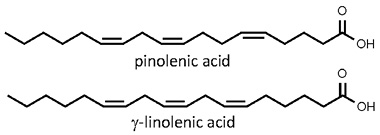 Pinus pinea
Pinus pinea
pine nuts
Back to “Spices: pine nuts (Pinus species)s”
Pinus pinea L. (Pinaceae); dennepitte (Afrikaans); cung zi, song zi ren (Chinese); pignons, pignoles (French); Pinienkerne (German); pignolia (Italian); matsu no mi (Japanese); jat (Korean); pinhões (Portuguese); piñónes (Spanish)
DESCRIPTION Ripe seeds (pine nuts) are off-white to pale brown in colour and oblong (European stone pine) or ovoid (Asian and American species) in shape. The seeds and seed oil have a delicious, somewhat resinous, spicy and nutty taste.
THE PLANT The stone pine is a large tree with a typical umbrella-shaped crown. Female cones have overlapping woody scales, each with two seeds on their upper side. About 20 Pinus species produce edible nuts. Korean pine (P. koraiensis) is the most important in international trade, but stone pine or Italian pine (P. pinea), Siberian pine (P. cembra), Mexican pine (P. cembroides) and the piñon (P. edulis) are also of considerable commercial importance.1
ORIGIN The use of pine nuts in the Mediterranean region and Asia dates back to ancient times. Pinus pinea is the main source of nuts in the Mediterranean, while P. koraiensis is the main species for oriental nuts. The latter is widely distributed in northeastern Asia, including China and Japan.
CULTIVATION Pine nuts are mostly obtained from natural stands of pines.
HARVESTING Seeds are gathered by hand and the nuts are mechanically extracted from the hard seed coat. The nuts easily become rancid and are best refrigerated or frozen to retain the flavour.
CULINARY USES Pine nuts are an important component of Mediterranean and Middle Eastern cuisines. They are an essential ingredient of pesto sauce, a popular flavourant and garnish of rice dishes and are used in meat, pasta, fish, poultry and egg dishes, as well as confectionery (bread, croissants, biscuits, tarts and pastries). Roasted nuts are a snack food or used for piñón (New Mexican pine nut coffee). Italian American pignoli cookies are sprinkled with pine nuts. Pine nuts or pine nut oil adds a delicious mild, nutty flavour to fresh salads (e.g. French salade landaise), Levantine kibbeh, Middle Eastern sambusak and other types of samosa, as well as Turkish baklava.
FLAVOUR COMPOUNDS The chemical compound(s) responsible for the flavour of pine nuts (and for that matter, most tree nuts except almonds, hazelnuts and Brazil nuts) appear to be as yet unknown.1 Pinolenic acid (an isomer of γ-linolenic acid or GLA) is a characteristic fatty acid found in the seeds and seed oil of Pinus species.1 The compound has appetite-suppressant effects2 and may reduce cholesterol. Siberian pine nut oil (rich in GLA) is used in Russia and China to treat peptic ulcers and gastritis.

NOTES Pine nut syndrome (pine mouth) is a unique taste disturbance, resulting in a bitter taste that may last for several weeks, caused by inedible Pinus armandii seeds.3 These seeds have been imported from China to France, Britain and the United States, where many people reported the symptoms. It is speculated that the continuing bitter taste in the mouth is caused by an activation of the bitter taste receptors in the gastrointestinal tract4 through enterohepatic recirculation of an as yet unidentified chemical compound.
1. Kamal-Eldin, A., Moreau, R.A. 2009. Tree nut oils. Chapter 3. In: Moreau, R.A., Kamal-Eldin, A. (Eds), Gourmet and Health- Promoting Specialty Oils. AOCS Press, Urbana, Illinois.
2. Hughes, G.M. et al. 2008. The effect of Korean pine nut oil (PinnoThinTM) on food intake, feeding behaviour and appetite: A double-blind placebo-controlled trial. Lipids in Health and Disease 7: 1−10.
3. Zonneveld, B.J.M. 2011. Pine nut syndrome: a simple test for genome size of 12 pine nut-producing trees links the bitter aftertaste to nuts of P. armandii Zucc. ex Endl. Plant Systematics and Evolution 297: 201−206.
4. Wu, S.V., Rozengurt, N., Yang, M., Young, S.H., Sinnett-Smith, J., Rozengurt, E. 2002. Expression of bitter taste receptors of the T2R family in the gastrointestinal tract and enteroendocrine STC-1 cells. Proceedings of the National Academy of Science 99: 2392− 2397.